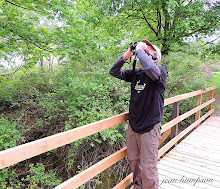
It was not until 2006 that I thought we should truly start maintaining lists of birds we encounter. Two of the observations in question are from our first year of birding.
The first bird in question is a Barrow's Goldeneye observed on 12 Mile Creek in February of 2006. We both cannot say for certain that we actually observed a Barrow's. Head colour was used in the identification but more attention to detail should have occurred. I did not let the inquiry from a regional reviewer, a highly experienced birder, intimidate me. I was not offended either. They have a job to do. Simply put, the experienced we have gained had us questioning ourselves.
The second observation in question was a male Harlequin Duck we found in Dufferin Islands in March of 2006. This one I'm keeping on the list. There is no doubt in our minds that this was a Harlequin Duck. It was considerably smaller than the many Mallards in the pond. The body was bluish gray with chestnut flanks and on the head, the white patch near the ear and the white crescent in front of the eye were very visible. The duck had all the markings of a breeding male Harlequin.
In late May of 2007, we thought we had observed a Worm-eating Warbler exploring the branches of a Walnut tree in our neighbour's yard. That would be freaking awesome if indeed it was a Worm-eating Warbler. Once again, with the experienced gained we have concluded that we most likely observed a Red-eyed Vireo. Spring appearances of Worm-eating Warblers in this area are very rare. The northern extent of the breeding range is found south of Ontario. Since 1956 only 24 Worm-eating Warblers have been observed in the Hamilton Study Area and the Niagara Region would have comparable data.
I am eagerly awaiting the publication of John and Kayo's book "Niagara Birds". It will be great to have a regional bird book sitting next to Bob Curry's book "Birds of Hamilton and Surrounding Areas" on our book shelf.
On March 15 of last year a visit to Jaycee Park in St. Catharines produced two observations that attracted the attention of the regional reviewer. From the park, an Eared Grebe was observed on Martindale Pond. The grebe we observed had a dark cheek and neck as opposed to the white cheek and throat of a Horned Grebe. The grebe also had a thin neck and a more pronounced crown. Thus I fully support our submission of Eared Grebe.
The second bird observed that day was a Ruby-crowned Kinglet. It was observed in a stand of coniferous trees with Black-capped Chickadee, Red-breasted Nuthatch, and White-breasted Nuthatch. Two white wing bars, a white eye ring and no apparent coloured crown were identified on this small bird. Though it was early in the year (the weather was mild that day) I still stand with my final answer of Ruby-crowned Kinglet.
The last observation in question is a Lesser Black-backed Gull found on the Lake Erie shore on August 31 of last year. Jean and I travelled to Morgan's Point Conservation Area to observe shorebirds. On the limestone shore, amongst some Herring, Bonaparte's, and Ring-billed Gulls was 1 Lesser Black-backed Gull. Size comparison of the gulls aided in the identification. It was not the largest gull present. The yellow legs, dark gray back and a yellow bill with a red spot on the lower mandible sealed the i.d. for a Lesser Black-backed Gull.
Of the discussed observations, the Barrow's Goldeneye and Worm-eating Warbler were lifers. Reflecting on these observations, I don't feel comfortable with keeping them on our life list. So the list is reduced by 2 to 253. Hey, no worries! It'll make the next time we actually observe these birds all the more worth while.







No comments:
Post a Comment